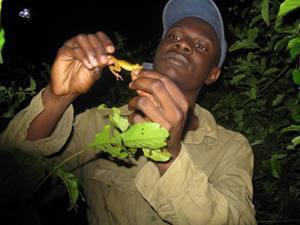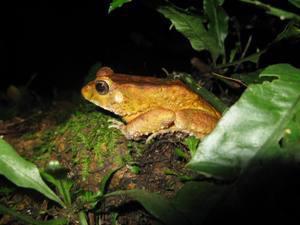Caleb Boateng Ofori
Other projects
9 Feb 2012
Conservation of the Togo Slippery Frog (Conraua derooi) in the Togo-Volta Hills
29 Jan 2014
Community-Driven Conservation of the Critically Endangered Togo Slippery Frog (Conraua derooi) in the Togo-Volta Hills of Ghana
25 May 2016
Scaling-Up Conservation Efforts for the Long-Term Protection of the Critically Endangered Togo-Slippery Frog (Conraua derooi) in Ghana
The project aims at conserving two Critically Endangered frogs through habitat restoration efforts and involvement of local communities in conservation planning and management.

Team leader examining Ghana's most endangered frog (C.derooi).
Two endemic Ghanaian frogs are threatened with extinction due to habitat loss and restricted geographical range. The species, Phrynobatrachus intermedius is known and described from only two adult females and one juvenile form whilst Phrynobatrachus jukwaensis, is restricted to a three-hectare forest fragment in the moist evergreen forest type of Ghana.

Amietophrynus togoensis.
The goal of this project is to save these species from extinction by determining and mapping their exact geographical ranges for conservation planning and involvement of local communities in species protection, habitat restoration and management. Four main activities are planned within this project, these include:
1. Education and capacity building;
2. Habitat restoration and extension;
3. Development of conservation guidelines;
4. Field surveys.
Conservation education and capacity building will be tailored to meet local training needs by enlightening rural people to halt all known causes of decline to these species and to benefit from alternative livelihood choices whilst reducing their dependence on the forest. Concurrently, native trees will be planted to restore and extend the habitat of Phrynobatrachus jukwaensis whilst providing breeding sites for several other threatened species. In addition to our enrichment planting and afforestation activities, we will facilitate the drafting of conservation guidelines by local communities. These will provide clear modalities for specific interventions on the species conservation based on the findings of our field studies and a proposed community based eco-tourism project.
To understand the distributional ranges of these and other threatened species, we will undertake a robust survey of amphibians in the high forest zone of Ghana with emphasis on endemic and endangered species using visual and acoustic survey techniques. We will map species location using Global Positioning System (GPS) and produce a distribution map of these species for conservation planning. This information will be critical in drafting the first Amphibian Conservation Action Plan for Ghana (ACAP).